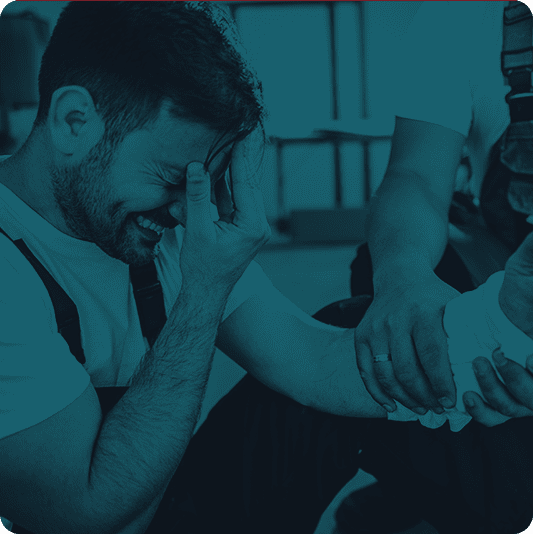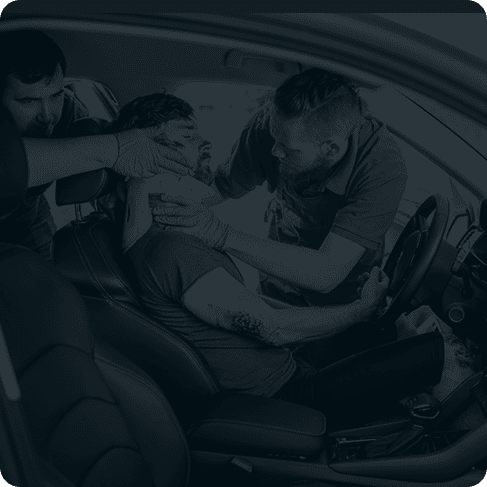With the sun, sand, and sidewalks Florida has to offer, riding bikes to get around is a popular method of travel. Before you head out to peddle to your next destination, it’s important to know and understand where you can ride your bike and the rules of the road while you’re pedaling around town.
Did you know that Florida considers bicycles vehicles? That means that bicyclists have to follow all of the same traffic laws and regulations a regular vehicles. Because of that, you’re probably already very familiar with Florida’s bicycle law.
Keep reading if you need a reminder about the Florida bicycle laws or are new to or visiting Florida.
Where Can I Ride My Bike in Florida?
On any given day, you’re bound to see bicyclists out and about in Florida and you might be wondering where they’re permitted to be riding their bikes. Before you get upset that someone is riding in the street or on a sidewalk, it’s helpful to know that bicycles are allowed to share those spaces with motor vehicles and pedestrians.
Bicycles are permitted to be ridden on streets, sidewalks, and in bike lanes throughout the state, except where prohibited by local ordinances. Motor vehicle drivers and cyclists alike have a duty to share the road together safely, if there is a designated bike lane or not. Cyclists are required to give pedestrians the right of way, whether they’re riding on the road, a bicycle path, or sidewalks.
Where there is a dedicated bicycle lane, it’s recommended that cyclists use those lanes unless you’re able to keep up with the same speed as the other vehicles on the roadway. When the road is too narrow or there is no bike lane, cyclists should stay to the right-hand curb or edge of the roadway unless you’re making a left lane turn.
For your safety, it’s best to avoid wearing headphones or earbuds while riding your bike in traffic, even when riding in a bike lane or on a sidewalk. You want to be able to see and hear the things happening around you. Bicycles are permitted on sidewalks but bicyclists riding on the sidewalk must yield to the right-of-way of any pedestrians and must give an audible signal before overtaking and passing a pedestrian.
Anyone under the age of 16 is required to wear a helmet while operating a bicycle so before you head out, make sure everyone is wearing a bicycle helmet that fits properly to keep safe in case there’s an accident or fall while you’re riding.
Do I Have to Follow the Rules of the Road?
Yes. Because a bicycle is considered a vehicle under Florida law, you’re required to follow the same rules of the road as a vehicle. This includes riding with the flow of traffic in the same direction, stopping at stop signs and red lights, yielding to traffic and pedestrians, allowing pedestrians the right of way, and having lights on at night.
Motor vehicles also need to be able to maintain the normal speed of traffic when a bicycle is sharing the road with them or you could be charged with impeding traffic. For narrow roads without bicycle lanes, cyclists should ride as far to the right of the lane as possible to allow motor vehicles to safely pass. Motor vehicles must stay at least three feet away from bicyclists when passing. With side mirrors, some of the larger vehicles can be eight feet wide or more, which is why a bike lane plus the adjacent lane must total at least 14 feet in width.
Bicyclists are not allowed to ride under the influence of alcohol or drugs and must obey all traffic signs under Florida law. Bicycle riding can be dangerous and it’s important that all riders are alert and able to pay attention to avoid any possible dangers. Bicycles can’t be used to carry more persons at a time than the number for which it was designed or equipped. The only exception would be an adult carrying a child securely attached to his/ her person in a backpack or sling. You cannot attach your bike or yourself to a vehicle. However, you can connect a bicycle trailer or semitrailer to your bike.
Rules for Bicycles
There are traffic controls and signals that are specific to bicycles in addition to rules you might be used to operating a motor vehicle from Florida Highway Safety Motor Vehicles that are important to know:
Seats – your bike must have a fixed, regular seat that’s used for riding your bicycle in a bike lane, on a sidewalk or bike path, or anywhere else.
Passengers – your bike can only be ridden by the number of people it was designed to ride, so if it’s meant for a single rider, only one person can legally ride that bike in Florida.
Hands Free Riding – at least one hand must be on the handlebars at all times when you’re riding your bicycle.
Brakes – every bike must have a break that will which will enable the bicyclist to stop within 25 feet from a speed of 10 miles per hour on dry, level, clean pavement.
Young Riders – parents or legal guardians are responsible for making sure the minors in their care are aware of laws and know the rules of the road.
Multiple Riders – if you’re out for a ride with other cyclists, you can ride two riders next to each other, so long as you’re not impeding traffic. Riding in a bike lane is a good choice when available, especially when you’re riding with multiple different bicycles.
Lighting – when riding your bicycle at night, you’re required to have a white light visible in the front and rear of your bicycle as well as a red reflector on the back of your bike.
Child seats – it’s illegal in Florida to leave a child unattended in a child seat or carrier on your bicycle. Passengers under four years old or 40 pounds need to be secured while riding a bike with a carrier, seat, sling, or backpack designed for use with children.
How Do I Properly Signal When Riding My Bike?
At some point on your adventure, you’ll need to make a turn. In order to follow the bicycle laws and local regulations, you’ll need to signal your turn but how do you do that on a bicycle? The National Highway Traffic Safety Administration created a handout to show the different signals.
Here are how to signal while riding a bicycle:
Left Turns
To let others you’re sharing a road with that you plan to make a left turn lane, simply hold your left arm straight out to the left. This will let other drives know about your upcoming left turn.
Right Turn
When you want to let others know you’re making a right turn, hold your left arm out and bend your arm upward at the elbow so your hand and forearm are pointing upwards.
Stopping
To signal a stop, hold your left arm out straight and bend it downward at the elbow so your hand and forearm are pointing down towards the ground.
Motor Vehicles and Bicyclists
In many areas, motor vehicles and cyclists need to share the road. As you can imagine, riding your bike in the street with other traffic can be a scary experience if you’re not familiar with the local traffic laws:
Traffic lanes – if the lanes are narrow, stay to the right side of the road near the edge of the roadway or curb. When a vehicle needs to pass, they should allow at least three feet between you and the vehicle.
Normal speed of traffic – you should be mindful of the normal speed limit and other vehicles on the roadway and not impede traffic by riding in the road.
Penalties for Bicyclists
Just like when operating a motor vehicle, there are penalties for not following the rules of the road while riding your bicycle. Even as a cyclist, you can be charged with moving and non-moving violations so it’s important to follow the local regulations, even when sidewalk riding your bicycle.
The Florida Statutes outline the different penalties associated with different infractions.
How Do I Stay Up to Date with Changes?
While we’re providing you information on the bicycle regulations, this shouldn’t be considered legal advice. We’re only able to provide current clients with that type of guidance for their specific situation.
It’s important to stay up to date on any changes to the laws for safely operating and riding your bike in Florida. The Florida Legislature has the most up to date statutes online for you to reference making it easy to stay up to date.
What If I’m an Accident While Riding My Bicycle?
No one ever wants to find them in an accident – especially one with a motor vehicle if you’re riding a bike. Just like any other accident, you should stay at the scene of the bicycle accident or find a safe place nearby to wait for local law enforcement and first responders to arrive.
If anyone is injured, call for help and do your best to keep them safe until an ambulance arrives. Collect the names of those involved or who witnessed the accident and write down any pertinent information. Taking pictures or video of the scene of the accident can be helpful if you’re able to. When a law enforcement officer arrives on the scene of the accident, give your report and ask for a copy.
Contact the professionals at Denmon Pearlman to help with your recovery process and navigating filing with the insurance companies to ensure you’re getting the settlement you deserve including pain and suffering damages. They’ll meet with you for a free one-hour no-obligation consultation to listen to your case and let you know how they can best help you.
When cycling on one of many bicycle paths in Tampa Bay or even on the roadways, it’s not only important to know bicycle safety but equally important to know the laws of operating a bicycle in Florida. Below is an illustration of Florida’s bicycle laws and regulations brought to you by Denmon Pearlman’s bicycle attorneys.
Our Expertise
We have your back. Whatever you might be suffering from, accidents, injuries or medical malpractice, we have you covered throughout Florida
Let’s get in touch!
The initial consultation is absolutely FREE
Denmon Pearlman
Law
St. Petersburg Office
520 2nd Ave South
St. Petersburg, FL 33701
(727) 800-4601
Denmon Pearlman
Law
New Port Richey Office
5703 Main Street
New Port Richey, FL 34652
(727) 478-0518
Denmon Pearlman
Law
Brooksville Office
1790 E Jefferson St.
Brooksville, FL 34601
(352) 309-7354
Denmon Pearlman
Law
Seminole Office
5290 Seminole Blvd. Suite D
St. Petersburg, FL 33708




